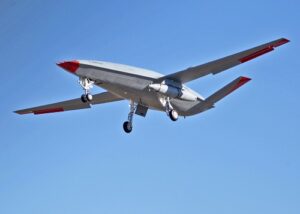The Naval Air Systems Command (NAVAIR) awarded Boeing [BA] a $47 million advance acquisition contract on Sept. 28 to prepare to build and deliver the low-rate initial production (LRIP) Lot 1 MQ-25 Stingray carrier-based unmanned tanker aircraft.
Work for this award will largely be split among facilities in Torrance, Calif. (36 percent); McKinney, Texas (19 percent); and St. Louis, Mo. (15 percent) and is expected to be finished by September 2026.

The contract is funded via fiscal year 2022 Navy aircraft procurement funds, with none expiring at the end of this fiscal year.
Capt. Sam Messer, Unmanned Carrier Aviation program manager, told Defense Daily in a statement that LRIP Lot 1 is planned to include four MQ-25 aircraft.
In 2018, the Navy first awarded Boeing an $805 million engineering and manufacturing development (EMD) contract to design, build, test and deliver four EMD MQ-25s (Defense Daily, Aug. 30, 2018).
Messer added that the EMD aircraft “will support the first deployment while LRIP 1 is necessary to support the second deployment and maintain continuity of fleet operations.”
The first operational MQ-25 Stingray is expected to be deployed aboard the USS Theodore Roosevelt (CVN-73) by 2026 while the Navy plans to procure 72 Stingrays total.
The first EMD model is planned to be delivered to the Navy by this upcoming winter, whereupon it will conduct carrier-based flight tests.
In 2021 the Navy and Boeing conducted several unmanned tanker to manned aircraft refueling tests with an F/A-18E/F Super Hornet, E-2D Advanced Hawkeye and F-35C Joint Strike Fighter (Defense Daily, Sept. 14, 2021).
The MQ-25 is expected to pass 15,000 pounds of gas at up to 500 nautical miles away from the carrier, replacing the current Super Hornets assigned to the task, which will be freed up for their original strike purposes.